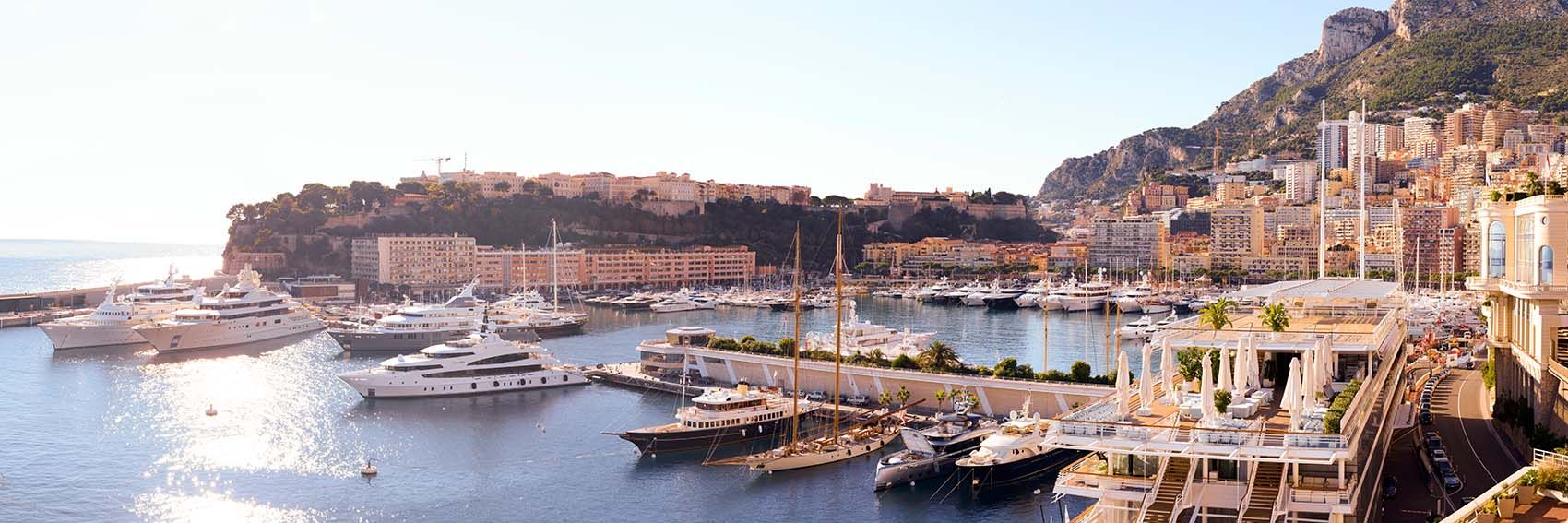
Inspired magazine
Featuring incredible insights and experiences of inspirational people from around the world, we explore some of the ultra-high net worth interests and passions that are thrilling and fascinating in equal measure.

21 August 2024
Please note: The external views expressed in this article are not the views of Barclays Private Bank, and forecasts are not a reliable indicator of future performance. Professional advice should always be sought when selling or buying property.
A shimmering new neighbourhood that is breaking new ground in more ways than one, has emerged on Monaco’s waterfront.
Mareterra, which opens to residents later this year, is a transformational development for the principality. This pioneering land reclamation project covers 14 acres1 and increases the size of the second-smallest independent state2 – only Vatican City is smaller – by 3%3. It also boasts the world’s most expensive real estate and is setting a new standard, as well as creating much-needed homes, for this unique housing market.
For more than 150 years, Monaco has been squeezing densely packed buildings into its area of just over two square kilometres, half the size of New York’s Central Park and constrained between mountains and the Mediterranean. Reclaiming land from the sea is not new – from the 1950s onwards, 20% of the principality’s surface area was reclaimed in this way4 – but Mareterra is unique in its ambition and scope.
Recognising the urgent need for more space, in May 2013, Prince Albert II’s government launched a call for applications for the construction of a new district through an urbanisation project in the sea. Initially called L’Anse du Portier, or Portier Cove, it is now known as Mareterra. The name, picked by the prince, is inspired by the two complementary elements of the project: the sea and the land.
At a cost of €2 billion, funded by private investors, this is Europe’s largest and most expensive real estate project, in large part due to the complex logistical and engineering challenge of building into the sea. Construction began in 2018, with materials delivered by boat to minimise impact on residents, while a team of marine biologists monitored the impact of the works on marine life.
Sustainability is at the core of Mareterra, Monaco’s first eco-district, where 800 trees are being planted and 600 metres of cycle path created. There are also 9,000 square metres of solar panels and huge heat pumps will use the sea water temperature to generate heat in winter and cooling in summer5.
Master-planned by the French architecture firm Valode & Pistre, the development comprises a collection of buildings with 110 apartments and 10 villas, six of which will be waterside6. The most eye-catching addition, at the westernmost end, is Le Renzo, a block of luxurious residences designed by the architect Renzo Piano. There are also public spaces, including a waterside promenade, a retail plaza and a small marina.
The properties have been sold to a carefully selected group of buyers, says Irene Luke, Co-head of Savills Monaco. “There’s a mix of nationalities, including French, Swiss, German, Italian and Bulgarian, as well as British,” she explains. “We are going to be seeing values of €100,000 a square metre and above on resales.”
Edward de Mallet Morgan, Head of International Super-Prime Sales at Knight Frank, says Mareterra is the most expensive real estate development project in the world. “It was almost all sold out off-plan two years before completion. Our prediction is that it will continue to set records for Monaco and, indeed, globally.”
For decades, the super-rich have clamoured to live in Monaco. The fewer than 40,000 residents include billionaires, the global elite and the famous, from people in the film and music industries to sportspeople. You need net wealth of at least US$12.9 million to join the top 1% here, according to Knight Frank, the highest threshold in the world7.
There are no levies on income, capital gains or property and the low-tax environment is, of course, incredibly attractive to the wealthy, but that’s not the only thing drawing them. “The traditional face of Monaco is changing – we’re increasingly seeing a younger clientele set up their family homes here given all the principality has to offer – from near-year-round sunshine to international schooling, as well as two ports for superyachts, internationally renowned restaurants and unrivalled shopping and safety, it’s not surprising that there is such demand to purchase a home here,” says Gerald Mathieu, Head of Private Bank Europe and Middle East, and CEO Monaco, at Barclays.
The clamour to live here has nevertheless been met with a chronic undersupply of property. Mareterra brings important new homes to the Larvotto seaside district, while this year will also see another large project complete in this area. Bay House features 56 apartments and five villas, as well as the new home of the International School.
Amid macro-economic uncertainty, Monaco has remained resilient and retains its crown as the most expensive residential property market in the world, according to Savills. Although sales are down – there were 416 individual transactions across the principality last year, a decline of around a fifth compared to 2022 – prices per square metre increased by 0.9% in 2023. This leaves values at an average of €51,418 per square metre, less than 1% below the record seen in 2021 and comfortably ahead of Hong Kong, at €39,100 a square metre, New York (€25,300) and London (€18,900)8.
Given its tiny size, most of the housing stock in Monaco is apartments. While Larvotto is the most expensive district by square metre, with prices rising to more than €65,000, only an average of four properties have sold each year since 2010 so this heavily skews the data, Savills says8.
According to Stephen Moroukian, Real Estate Financing Director at Barclays Private Bank, the race for space that began during the pandemic is still being felt. And it’s becoming more acute because of a change in approach to residence card applications in recent years.
“The property size must now match with the size of the family applying for residence and this has led to higher demand for larger homes,” he explains. “Given the long-standing global demand for Monaco’s real estate, this extra buyer criteria adds a nuanced dynamic to an already competitive market.”
According to Ianis Ennaji, a Senior Private Banker at Barclays Private Bank Monaco, the principality remains a property hotspot like no other. “Monaco is attracting an increasing number of ultra-high-net-worth individuals every year and so the demand for large, high-quality family homes has been on the rise,” he reflects.
“Against this backdrop, Mareterra ticks a number of boxes for house hunters – high spec, sea views, concierge and leisure facilities, to name just a few of the credentials. The overall quality and luxury on offer is noticeable.”
While there is caution on inflation, interest rates and global politics – this is, after all, the biggest election year in human history – Monaco real estate looks set to retain its perceived safe-haven status. Knight Frank has forecasted the number of ultra-high-net-worth individuals there worth more than US$30 million will rise by 23% between 2021 and 20269.
“Demand for high-end property across the Côte d'Azur shows little sign of abating. While other places are often impacted by interest rates and inflation, we see a buoyant market prevailing here,” concludes Gerald Mathieu. “With the promise of luxury, exclusivity and quality lifestyle combined, it’s not hard to understand why the Riviera, Monaco and now the Mareterra, are in such high demand.”

Featuring incredible insights and experiences of inspirational people from around the world, we explore some of the ultra-high net worth interests and passions that are thrilling and fascinating in equal measure.
This communication is general in nature and provided for information/educational purposes only. It does not take into account any specific investment objectives, the financial situation or particular needs of any particular person. It not intended for distribution, publication, or use in any jurisdiction where such distribution, publication, or use would be unlawful, nor is it aimed at any person or entity to whom it would be unlawful for them to access.
This communication has been prepared by Barclays Private Bank (Barclays) and references to Barclays includes any entity within the Barclays group of companies.
This communication:
(i) is not research nor a product of the Barclays Research department. Any views expressed in these materials may differ from those of the Barclays Research department. All opinions and estimates are given as of the date of the materials and are subject to change. Barclays is not obliged to inform recipients of these materials of any change to such opinions or estimates;
(ii) is not an offer, an invitation or a recommendation to enter into any product or service and does not constitute a solicitation to buy or sell securities, investment advice or a personal recommendation;
(iii) is confidential and no part may be reproduced, distributed or transmitted without the prior written permission of Barclays; and
(iv) has not been reviewed or approved by any regulatory authority.
Any past or simulated past performance including back-testing, modelling or scenario analysis, or future projections contained in this communication is no indication as to future performance. No representation is made as to the accuracy of the assumptions made in this communication, or completeness of, any modelling, scenario analysis or back-testing. The value of any investment may also fluctuate as a result of market changes.
Where information in this communication has been obtained from third party sources, we believe those sources to be reliable but we do not guarantee the information’s accuracy and you should note that it may be incomplete or condensed.
Neither Barclays nor any of its directors, officers, employees, representatives or agents, accepts any liability whatsoever for any direct, indirect or consequential losses (in contract, tort or otherwise) arising from the use of this communication or its contents or reliance on the information contained herein, except to the extent this would be prohibited by law or regulation.
Robb Report, ‘Exclusive: Monaco Created a Ritzy, Multibillion-Dollar Neighborhood From Scratch – Here’s a Look Inside’, 6 August 2023Return to reference
The Embassy of Monaco in Washington DC website, ‘Key Facts’, 24 June 2024Return to reference
Monaco Tribune, ‘Mareterra to be completed in 2024, 22 November 2023Return to reference
Mareterra, ‘The Organisation of the Mareterra Project’, May 2021Return to reference
Mareterra website, ‘Facts and Figures’, 14 June 2024Return to reference
Savills website, ‘Mareterra Monaco’, 14 June 2024Return to reference
Knight Frank, ‘The Next Edition, The Wealth Report, 18th Edition’, 2024Return to reference
Savills, ‘Spotlight: Monaco – 2024’, 18 March 2024Return to reference
Knight Frank, ‘Monaco in pole position as a new era of higher taxes beckons’, 27 May 2022Return to reference